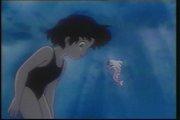Fukuyama Theater "Natsu no Himitsu" Review: A moving film that unravels the secrets of summer

Fukuyama Theater's Summer Secret - Fukuyama Theater's Summer Secret■ Public MediaOVA ■ Original Mediacomics ■ Release dateSeptember 27, 1990 ■Release and salesEMI Music Japan ■Frequencies60 min ■ Number of EpisodesEpisode 10 ■Original StoryFukuyama Keiko ■ DirectorMichiyo Sakurai ■ ProductionYumex, Urban Products ■Works©Keiko Fukuyama, Urban Product, Umex ■ StoryDuring the Stone Age, the young mural painter Henoheno is inspired by the popularity of Moheji, a senior mural painter, and begins creating original murals ("Henoheno"). ■ExplanationThis is an anthology animated version of Fukuyama Keiko's original manga. It is a collection of 10 short stories, including the title story "The Secret of Summer." The story is about a mother mouse reading 10 picture books to a little mouse who cannot fall asleep. Although the content is aimed at children, it is packed with depth and humor that adults can enjoy as well. Each episode is independent, with different themes and characters, but the overall feel is warm and gentle. In particular, the relationship between the mother mouse and the little mouse is full of touching scenes depicting the bond between parent and child, warming the hearts of viewers. Furthermore, the stories of each episode are simple, yet have strong messages that give children dreams and hope. ■Cast (※ Role name unknown due to lack of information) ■ Main staff・General Director / Michiyo Sakurai・Storyboard / Michiyo Sakurai・Producers / Junji Fujita, Isao Yonekawa・Producers / Hiroshi Tazaki, Michiyo Sakurai・Original Story / Keiko Fukuyama・Adaptation / Michiyo Sakurai・Key Animation / Michiyo Sakurai, Makiko Yamauchi, Keiko Hattori, Mamoru Sasaki, Kyoko Nakano, Hiroki Sugawara, Masafumi Yamamoto・Animation Inspection / Hisama Oshita・Art Director / Mariko Kado・Director of Photography / Kinichi Ishikawa・Color Design / Fumiko Ito・Sound Producer / Keiko Senda・Sound Director / Sadayoshi Fujino・Music / Toshiyuki Watanabe・Production Manager / Tetsuro Kumase・Color Inspection / Fumiko Ito・Production / UMEX, URBAN PRODUCTS ■ Main Characters -Mother Mouse reads 10 picture books to her little mouse who cannot sleep. ■Subtitle・Rabbit Siblings・Summer Secret・Punk Rabbit Dance・Mysterious Fairy・Origami Princess・Henoheno・End of Term Cleaning Festival・Mouse and Child・KURO ■ Theme songs and music・IN1 ■Detailed evaluation"Fukuyama Theater: Summer Secret" was released as an OVA in 1990, and is an omnibus-style animation based on the original manga by Fukuyama Keiko. This work, which consists of 10 episodes, has a unique structure in which a mother mouse reads a picture book to a little mouse who cannot sleep, and each episode has its own independent story. Below, we will explain in detail the appeal and features of this work. Story and ThemesEach episode deals with a different theme, and although the content is aimed at children, it has depth that adults can enjoy as well. For example, "The Rabbit Siblings" depicts brotherly love, "The Secret of Summer" depicts friendship, and "The Punk Rabbit Dance" depicts the joy of freedom and expression. "Henoheno" also depicts the struggles of an artist and the path to success, while "End of Term Cleaning Festival" conveys the importance of cooperation and solidarity. These themes not only give children dreams and hope, but also contain many elements that make adults think. characterThe characters in this work are particularly memorable, especially the relationship between the mother mouse and the little mouse. The scene in which the mother mouse's kindness and love is conveyed to the little mouse through the picture book warms the hearts of viewers. The characters that appear in each episode are also unique and leave a strong impression on viewers. For example, "Henoheno" is depicted as a young mural artist struggling to make ends meet, and his growth and path to success are inspiring. "Moheji" appears as a popular mural artist, and is portrayed as a role model for Henoheno. Animation and ArtThe quality of the animation is extremely high, with the backgrounds and character movements of each episode carefully drawn in detail. In particular, the scene depicting the painting of stone-age murals and the rabbits' dancing scene stand out for their beautiful colors and movements. Additionally, the background art by art director Kado Mariko plays an important role in enhancing the atmosphere of each episode. Cinematographer Ishikawa Kinichi's camerawork is also used skillfully in line with the progression of the story, enhancing the visual appeal. Music and SoundThe music was composed by Watanabe Toshiyuki, and the beautiful melodies that matched the theme of each episode were memorable. In particular, theme songs such as "Punk Rabbit Dance," "KURO," "Blue Sand Dunes," and "Ninjin Boogie" have left a lasting impression on viewers. Additionally, the sound effects by sound director Fujino Sadayoshi are also an important element in enhancing the realism of the story. For example, in the scene where Stone Age murals are being painted, the movement of the brush and the sound of the stones are realistically reproduced, heightening the viewer's sense of immersion. Cast and actingThe cast is made up of a star-studded cast of voice actors, including Taguchi Kumiko, Touma Yumi, Inaba Minoru, Takamori Yoshino, Matsuno Tatsuya, Hara Eriko, Shioya Tsubasa, Matsumoto Yasunori, Yajima Akiko, Kikuchi Masami, and Fujieda Nariko. The voices of each character are performed to suit their roles, and play an important role in evoking the emotions of the viewers. In particular, the voice actors' performances realistically express the mother mouse's kindness and the little mouse's innocence. Furthermore, the voice actors' performances also convey Henoheno's struggles and joy at success to the viewers. Production StaffMichiyo Sakurai, who was the general director and storyboard artist, decided the overall direction of the work and skillfully put together the stories of each episode. Her vision played a key role in bringing Fukuyama Keiko's worldview, the original work, to life in animation. The key animators Michiyo Sakurai, Makiko Yamauchi, Keiko Hattori, Mamoru Sasaki, Kyoko Nakano, Hiroki Sugawara, Masafumi Yamamoto and other staff members also worked hard to enhance the visuals of each episode. Production companies Youmex and Urban Productions also played an important role in supporting the quality of this work. ■Recommendation detailsAlthough "Fukuyama Theater: Summer Secret" is an animation aimed at children, it is full of depth and humor that adults can enjoy as well. Each episode is independent, so viewers can watch it in the order they like, and they can enjoy it without getting bored. In addition, the relationship between the mother mouse and the little mouse, as well as the theme of each episode, contain many touching scenes that warm the hearts of viewers, and the story depicts the bond and friendship between parents and children, as well as dreams and hopes, which is impressive. The animation quality is also high, and the beauty of the colors and movements stands out. The music and sound effects are also important elements that enhance the realism of the story. The performances by the splendid voice actors also play an important role in bringing out the emotions of the viewers. Thanks to the efforts of the production staff, this work has achieved high quality and will leave a strong impression on viewers. The reasons why I recommend this work are as follows: Although it's for kids, adults can enjoy it tooAlthough "Fukuyama Theater: Summer Secret" is an animation aimed at children, it is packed with depth and humor that adults can enjoy as well. The themes of each episode not only give children dreams and hope, but also contain many elements that make adults think. For example, "Henoheno" depicts the struggles of an artist and his path to success, allowing viewers to share in Henoheno's growth and joy at success. In addition, "End of Term Cleaning Ceremony" conveys the importance of cooperation and unity, a message that viewers can empathize with. These themes are deeply moving for adults as well as children, and are a major reason for recommending this work. A touching scene depicting the bond between parent and childThe relationship between the mother mouse and the little mouse is one of the major attractions of this work. The scene where the mother mouse reads a picture book to the little mouse, who cannot sleep, is a touching scene that warms the hearts of viewers. The moment when the mother mouse's kindness and love is conveyed to the little mouse through the picture book is a beautiful scene depicting the bond between parent and child, and leaves a strong impression on viewers. Scenes like this are particularly touching for viewers who value the bond between parent and child, and are a reason to recommend this work. High animation qualityThe quality of the animation is extremely high, with the backgrounds and character movements in each episode carefully drawn down to the smallest detail. In particular, the scene depicting the stone-age murals and the rabbits' dancing scene are striking in their beauty of color and movement. Additionally, the background art by art director Kado Mariko plays an important role in enhancing the atmosphere of each episode. Cinematographer Ishikawa Kinichi's camerawork is also used skillfully in line with the progression of the story, enhancing the visual appeal. These elements leave a strong impression on the viewer, and are reasons to recommend this work. Beautiful music and sound effectsThe music was composed by Watanabe Toshiyuki, and the beautiful melodies that match the theme of each episode are memorable. In particular, theme songs such as "Punk Rabbit Dance," "KURO," "Blue Sand Dunes," and "Ninjin Boogie" have left a lasting impression on viewers. Additionally, the sound effects by sound director Fujino Sadayoshi are also an important element in enhancing the realism of the story. For example, in the scene where Stone Age murals are being painted, the brush strokes and the sounds of the stones are realistically reproduced, enhancing the viewer's sense of immersion. These elements play an important role in bringing out the emotions of the viewer, and are reasons to recommend this work. Performances by a stellar cast of voice actorsThe cast is an all-star cast of voice actors, including Taguchi Kumiko, Touma Yumi, Inaba Minoru, Takamori Yoshino, Matsuno Tatsuya, Hara Eriko, Shioya Tsubasa, Matsumoto Yasunori, Yajima Akiko, Kikuchi Masami, and Fujieda Nariko. The voices of each character are performed to suit their roles, and play an important role in evoking the emotions of the viewer. In particular, the voice actors' performances realistically express the mother mouse's kindness and the little mouse's innocence. Furthermore, the voice actors' performances also convey Henoheno's struggles and joy at success to the viewer. These elements play an important role in evoking the emotions of the viewer, and are the reasons why we recommend this work. The efforts of the production staffMichiyo Sakurai, who was the general director and storyboard artist, decided the overall direction of the work and skillfully put together the stories of each episode. Her vision played a key role in recreating the worldview of Fukuyama Keiko, the original author, in animation. In addition, the staff members who were in charge of key animation, including Michiyo Sakurai, Makiko Yamauchi, Keiko Hattori, Mamoru Sasaki, Kyoko Nakano, Hiroki Sugawara, and Masafumi Yamamoto, also worked hard to enhance the visuals of each episode. Youmex and Urban Productions, who were in charge of production, also played an important role in supporting the quality of this work. Thanks to the efforts of these staff members, this work has achieved high quality and is a work that leaves a strong impression on viewers. The efforts of the production staff are a major reason for recommending this work. ConclusionAlthough "Fukuyama Theater: Summer Secret" is an animation aimed at children, it is full of depth and humor that adults can enjoy as well. Each episode is independent, so viewers can watch it in the order they like, and they can enjoy it without getting bored. In addition, the relationship between the mother mouse and the little mouse, as well as the theme of each episode, have many touching scenes that warm the hearts of viewers, and the story depicts the bond and friendship between parents and children, as well as dreams and hopes, which is impressive. The animation quality is high, and the beauty of the colors and movements stands out. The music and sound effects are also important elements that enhance the realism of the story. The performances by the luxurious voice actors also play an important role in bringing out the emotions of the viewers. Thanks to the efforts of the production staff, this work has achieved high quality and leaves a strong impression on the viewers. These elements make it possible to say that "Fukuyama Theater: Summer Secret" is a work that can be recommended to a wide range of viewers, from children to adults. |
<<: A thorough evaluation of the (secret) hand power of ``IKENAI BOY'' - just how good will it be?
>>: The appeal and reviews of "Adventure!! Ikusa 3": Unmissable action and story
Recommend
Foreign media revealed the inside story of Justin Lin's withdrawal from "Fast and Furious 10" and Universal lost millions of dollars a day
"Fast & Furious 10" just started fi...
The first trailer of the TV series "Douluo Continent" was released, starring Xiao Zhan and Wu Xuanyi
Today (October 27), the first season trailer of t...
Sigourney Weaver confirmed to star in The Mandalorian and Googu
"Alien Queen" Sigourney Weaver arrived ...
Doctor Strange to join Holland in Spider-Man 3 as his mentor
Following Tony Stark played by Robert Downey Jr. ...
"A Dream Comes True" review: A fascinating story and deep characters
The appeal and reputation of Momokagettan ■ Publi...
The appeal and evaluation of the first chapter of the movie "Hakuoki": Kyoto Ranbu
Hakuouki the Movie Chapter 1: Kyoto Ranbu overvie...
The Last of Us Part II composer to work on HBO series adaptation
Neil Druckmann, game director of The Last of Us 2...
DC's "The Flash" new trailer double flash, Supergirl, Gay and Batman team up
The second trailer of DC's new film "The...
The appeal and reviews of "Anoko ni 1000%": A moving story and deep characters
"Anoko ni 1000%" - The charm of the OVA...
The legendary manga "Akira" 4K theatrical version will be released on March 14th and will be the opening of the Tokyo Anime Festival
The 4K remake of the legendary manga "Akira&...
A thorough review of "Aim for the Ace!", the Cinderella story of the tennis kingdom
"Aim for the Ace!" - Cinderella of the ...
Minami-ke review: Will the long-awaited sequel exceed expectations?
Minami-ke: Sorry to keep you waiting: The appeal ...
The first trailer of the new AI-remade "Terminator 2" movie will be released on March 6
Currently, Hollywood has no plans to completely r...
"TOKYO VICE" Review: A thrilling drama depicting the worlds of journalism and the Yakuza
TOKYO VICE - Tokyo Vice - comprehensive evaluatio...
The appeal and evaluation of the first quarter of "SPY×FAMILY" Season 1
The appeal and evaluation of the first season of ...









